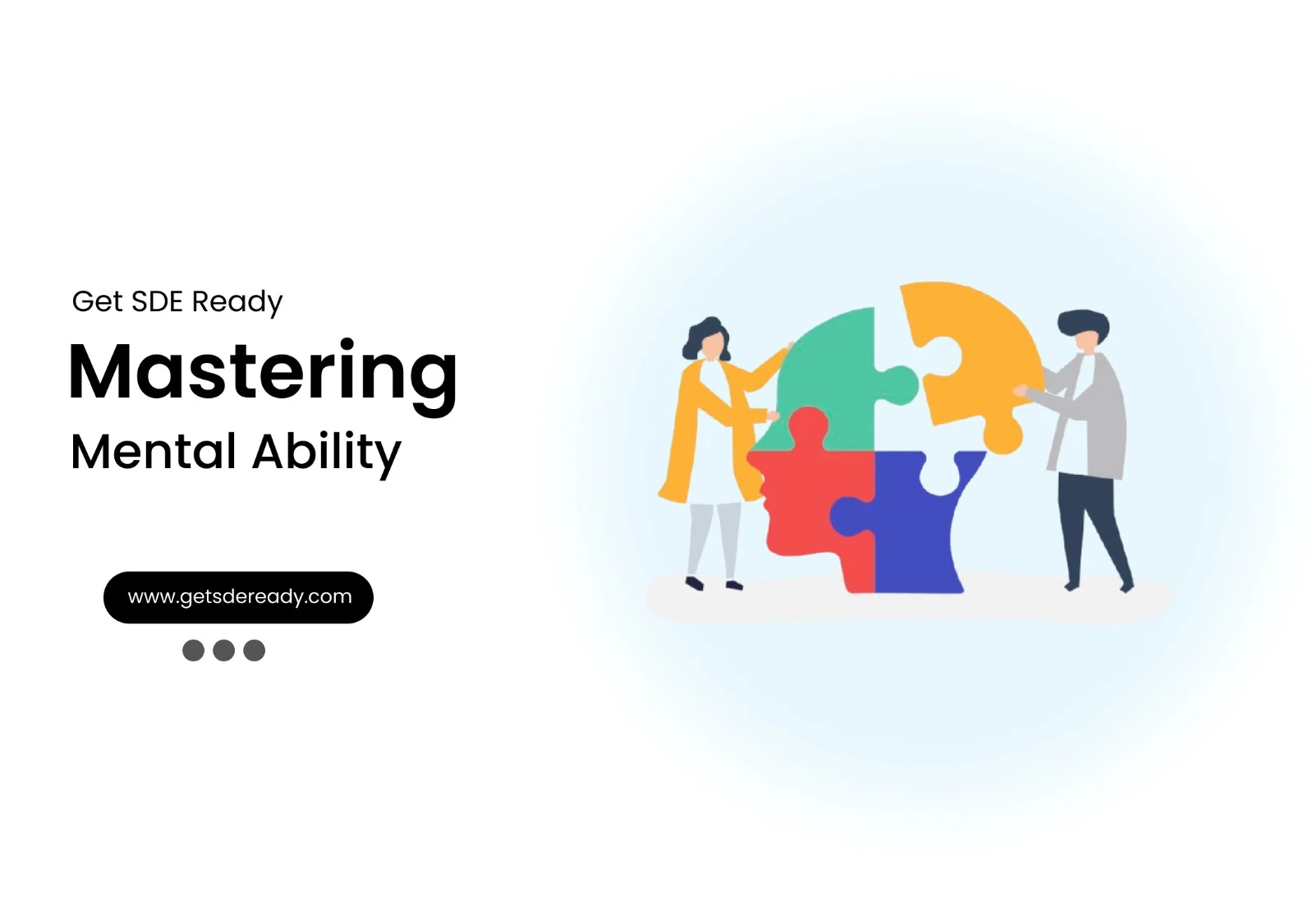Introduction to High-Level System Design
System Design Fundamentals
- Functional vs. Non-Functional Requirements
- Scalability, Availability, and Reliability
- Latency and Throughput Considerations
- Load Balancing Strategies
Architectural Patterns
- Monolithic vs. Microservices Architecture
- Layered Architecture
- Event-Driven Architecture
- Serverless Architecture
- Model-View-Controller (MVC) Pattern
- CQRS (Command Query Responsibility Segregation)
Scaling Strategies
- Vertical Scaling vs. Horizontal Scaling
- Sharding and Partitioning
- Data Replication and Consistency Models
- Load Balancing Strategies
- CDN and Edge Computing
Database Design in HLD
- SQL vs. NoSQL Databases
- CAP Theorem and its Impact on System Design
- Database Indexing and Query Optimization
- Database Sharding and Partitioning
- Replication Strategies
API Design and Communication
Caching Strategies
- Types of Caching
- Cache Invalidation Strategies
- Redis vs. Memcached
- Cache-Aside, Write-Through, and Write-Behind Strategies
Message Queues and Event-Driven Systems
- Kafka vs. RabbitMQ vs. SQS
- Pub-Sub vs. Point-to-Point Messaging
- Handling Asynchronous Workloads
- Eventual Consistency in Distributed Systems
Security in System Design
Observability and Monitoring
- Logging Strategies (ELK Stack, Prometheus, Grafana)
- API Security Best Practices
- Secure Data Storage and Access Control
- DDoS Protection and Rate Limiting
Real-World System Design Case Studies
- Distributed locking (Locking and its Types)
- Memory leaks and Out of memory issues
- HLD of YouTube
- HLD of WhatsApp
System Design Interview Questions
- Adobe System Design Interview Questions
- Top Atlassian System Design Interview Questions
- Top Amazon System Design Interview Questions
- Top Microsoft System Design Interview Questions
- Top Meta (Facebook) System Design Interview Questions
- Top Netflix System Design Interview Questions
- Top Uber System Design Interview Questions
- Top Google System Design Interview Questions
- Top Apple System Design Interview Questions
- Top Airbnb System Design Interview Questions
- Top 10 System Design Interview Questions
- Mobile App System Design Interview Questions
- Top 20 Stripe System Design Interview Questions
- Top Shopify System Design Interview Questions
- Top 20 System Design Interview Questions
- Top Advanced System Design Questions
- Most-Frequented System Design Questions in Big Tech Interviews
- What Interviewers Look for in System Design Questions
- Critical System Design Questions to Crack Any Tech Interview
- Top 20 API Design Questions for System Design Interviews
- Top 10 Steps to Create a System Design Portfolio for Developers
Data Structures and Algorithms
- Introduction to Data Structures and Algorithms
- Time and Space Complexity Analysis
- Big-O, Big-Theta, and Big-Omega Notations
- Recursion and Backtracking
- Divide and Conquer Algorithm
- Dynamic Programming: Memoization vs. Tabulation
- Greedy Algorithms and Their Use Cases
- Understanding Arrays: Types and Operations
- Linear Search vs. Binary Search
- Sorting Algorithms: Bubble, Insertion, Selection, and Merge Sort
- QuickSort: Explanation and Implementation
- Heap Sort and Its Applications
- Counting Sort, Radix Sort, and Bucket Sort
- Hashing Techniques: Hash Tables and Collisions
- Open Addressing vs. Separate Chaining in Hashing
- DSA Questions for Beginners
- Advanced DSA Questions for Competitive Programming
- Top 10 DSA Questions to Crack Your Next Coding Test
- Top 50 DSA Questions Every Programmer Should Practice
- Top Atlassian DSA Interview Questions
- Top Amazon DSA Interview Questions
- Top Microsoft DSA Interview Questions
- Top Meta (Facebook) DSA Interview Questions
- Netflix DSA Interview Questions and Preparation Guide
- Top 20 DSA Interview Questions You Need to Know
- Top Uber DSA Interview Questions and Solutions
- Google DSA Interview Questions and How to Prepare
- Airbnb DSA Interview Questions and How to Solve Them
- Mobile App DSA Interview Questions and Solutions
DSA Interview Questions
- DSA Questions for Beginners
- Advanced DSA Questions for Competitive Programming
- Top 10 DSA Questions to Crack Your Next Coding Test
- Top 50 DSA Questions Every Programmer Should Practice
- Top Atlassian DSA Interview Questions
- Top Amazon DSA Interview Questions
- Top Microsoft DSA Interview Questions
- Top Meta (Facebook) DSA Interview Questions
- Netflix DSA Interview Questions and Preparation Guide
- Top 20 DSA Interview Questions You Need to Know
- Top Uber DSA Interview Questions and Solutions
- Google DSA Interview Questions and How to Prepare
- Airbnb DSA Interview Questions and How to Solve Them
- Mobile App DSA Interview Questions and Solutions
Introduction to Low-Level Design (LLD) for Beginners
Low-level design (LLD) is an essential step in software engineering that bridges high-level architecture with actual code implementation. For beginners, it involves breaking down system requirements into detailed classes, methods, and interactions while applying principles like SOLID and design patterns to ensure maintainability and scalability. Research suggests LLD helps reduce bugs by up to 30% in development phases, making it a key skill for aspiring developers. If you’re ready to build practical skills and stay updated with free resources, sign up for our exclusive course updates to access beginner-friendly tutorials and projects.
Key Points
- Core Focus: LLD emphasizes object-oriented design, UML diagrams, and modular components for efficient software building.
- Benefits for Beginners: It teaches how to create flexible code, though it can be challenging without strong OOP foundations—evidence leans toward practicing with simple systems like games to gain confidence.
- Common Challenges: Novices often overlook design patterns, leading to rigid code; however, starting with basics like Singleton or Factory can mitigate this.
- Career Relevance: Mastering LLD is crucial for tech interviews, where questions test real-world application, but remember it’s a skill that evolves with experience.
What You’ll Learn Here
This guide covers fundamentals, tools, and practices to get started with LLD.
Quick Tips to Begin
Start by learning OOP concepts through resources like our DSA course, then practice diagramming simple apps.
Low-level design (LLD) might sound intimidating if you’re just starting out in software development, but think of it as the blueprint that turns big ideas into working code. Imagine you’re building a house: high-level design (HLD) sketches the overall layout, like where the rooms go, but LLD gets into the nitty-gritty—how the doors hinge, what materials to use for the wiring, and how everything connects seamlessly. As a beginner, grasping LLD early can set you apart, especially in a field where efficient, scalable software is king. According to industry reports, teams that invest in solid LLD practices see fewer production issues and faster iteration times. In this comprehensive guide, we’ll dive deep into what LLD is, why it matters, key concepts, tools, best practices, and even real-world interview questions to prepare you for the job market. By the end, you’ll have actionable steps to start designing your own systems.
What is Low-Level Design?
Low-level design is the phase in the software development lifecycle (SDLC) where you translate high-level requirements into detailed specifications for implementation. Unlike HLD, which focuses on system architecture and components at a macro level, LLD zooms in on the micro-details: classes, interfaces, methods, data structures, and algorithms. It’s all about “how” the system will work internally, ensuring that the code is modular, reusable, and efficient.
Differences Between HLD and LLD
To clarify, let’s compare the two in a table:
Aspect | High-Level Design (HLD) | Low-Level Design (LLD) |
Focus | Overall system structure and modules | Detailed implementation of each module |
Output | Architectural diagrams, component overviews | Class diagrams, method signatures, pseudocode |
Audience | Architects, stakeholders | Developers, testers |
Depth | Abstract, high-level | Concrete, code-ready |
Tools Used | Flowcharts, ER diagrams | UML diagrams, design pattern catalogs |
This distinction is crucial because skipping straight to code without LLD often leads to spaghetti code—tangled and hard to maintain. For beginners, starting with LLD helps build good habits from day one.
Why is LLD Important for Beginners?
As a newcomer, you might wonder why bother with design when you can just code. Well, LLD teaches you to think like an engineer. It promotes clean code that scales, reduces debugging time, and makes collaboration easier. Statistics from software engineering studies show that poor design accounts for over 50% of project failures. Plus, in interviews at companies like Google or Amazon, LLD questions are common to assess your problem-solving depth. Learning it now through structured courses, like our master DSA, web dev, and system design program, can accelerate your career.
Key Concepts in Low-Level Design
LLD revolves around object-oriented programming (OOP) principles, as most modern software is built this way. Let’s break it down.
Object-Oriented Programming Basics
At its core, LLD uses classes and objects to model real-world entities. For example, in a banking app, a “Account” class might have properties like balance and methods like deposit(). Key OOP pillars include:
- Encapsulation: Bundling data and methods to protect internal states.
- Inheritance: Reusing code by creating hierarchies (e.g., SavingsAccount extends Account).
- Polymorphism: Allowing objects to be treated as instances of their parent class.
- Abstraction: Hiding complex details behind simple interfaces.
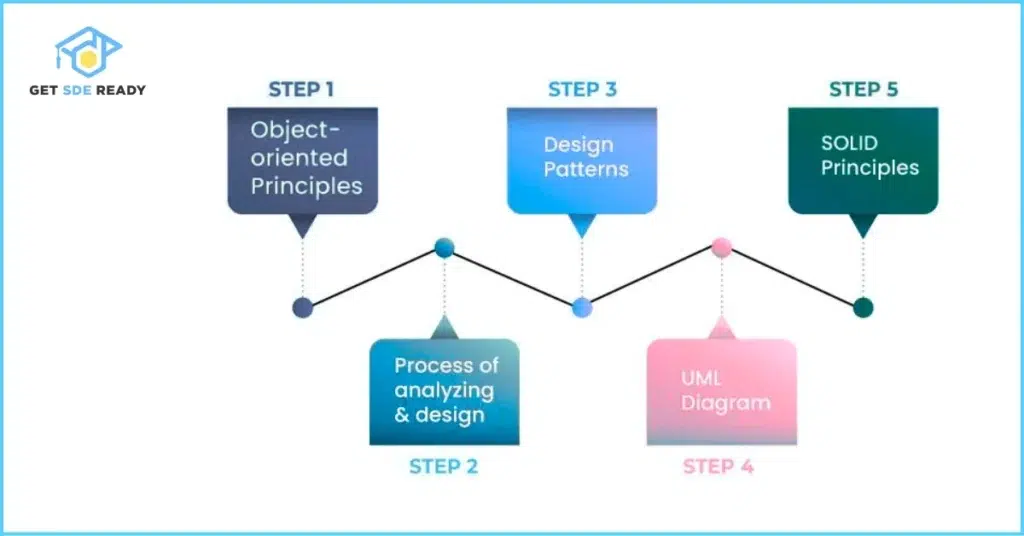
Beginners should practice these in languages like Java or Python. If you’re into web development, check our web development course for OOP applications in full-stack apps.
SOLID Principles
These are the golden rules for robust LLD, coined by Robert C. Martin.
- S (Single Responsibility): A class should have one job—e.g., a User class handles user data, not payments.
- O (Open-Closed): Open for extension, closed for modification—use interfaces to add features without changing existing code.
- L (Liskov Substitution): Subclasses should replace base classes without breaking functionality.
- I (Interface Segregation): Many small interfaces are better than one large one.
- D (Dependency Inversion): Depend on abstractions, not concretes—inject dependencies for flexibility.
Applying SOLID makes your designs future-proof. For instance, in data science projects, SOLID helps structure models cleanly; explore more in our data science course.
Design Patterns
These are reusable solutions to common problems. Categories include:
- Creational: Singleton (one instance), Factory (object creation).
- Structural: Adapter (interface compatibility), Composite (tree structures).
- Behavioral: Observer (event notifications), Strategy (algorithm swapping).
For beginners, start with Singleton for global resources like databases.
UML Diagrams in LLD
Unified Modeling Language (UML) is your visual toolkit for LLD.
Class Diagrams
Show classes, attributes, methods, and relationships (e.g., association, inheritance).
Sequence Diagrams
Illustrate method calls over time—great for understanding interactions.
Use Case Diagrams
Depict user-system interactions.
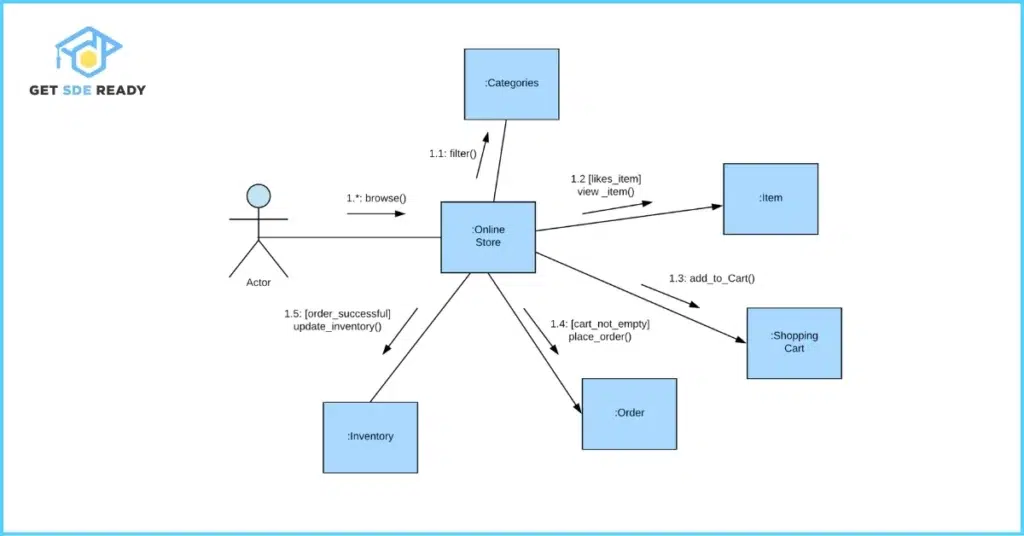
Tools like Lucidchart or PlantUML make this easy. Practice by diagramming a simple app, like a to-do list.
Step-by-Step Approach to Creating an LLD
Here’s how to tackle LLD as a beginner:
- Gather Requirements: Clarify what the system must do—e.g., for a chat app, handle messages, users, notifications.
- Identify Entities: List classes like User, Message.
- Define Relationships: Use UML to connect them.
- Apply Patterns and Principles: Ensure SOLID compliance.
- Write Pseudocode: Outline methods.
- Review and Iterate: Test for edge cases.
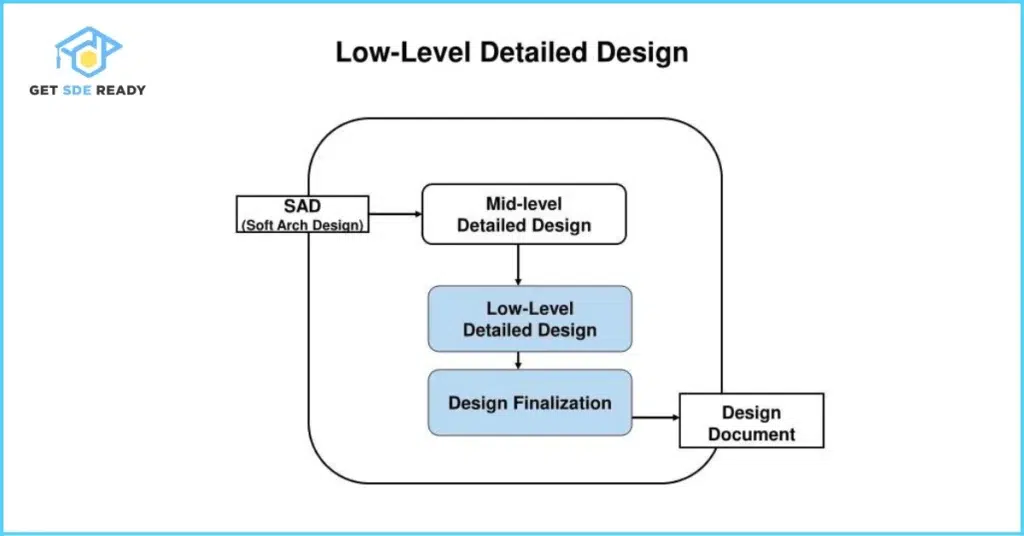
For quick mastery, try our crash course on system design fundamentals.
Best Practices for Effective LLD
- Keep It Modular: Break into small, testable units.
- Prioritize Readability: Use meaningful names, comments.
- Handle Errors Gracefully: Plan for failures.
- Optimize for Performance: Choose efficient data structures.
- Document Thoroughly: Include diagrams, explanations.
Common pitfalls: Over-designing (KISS principle—Keep It Simple, Stupid) or ignoring scalability.
Real-World Examples
Let’s apply LLD to a simple vending machine:
- Classes: VendingMachine, Product, Payment.
- Relationships: VendingMachine has Products.
- Methods: selectProduct(), processPayment().
Extend this to complex systems like e-commerce.
(Alt text: UML Class Diagram for Vending Machine – showing classes and associations.)
Preparing for LLD Interviews: 30 Real Questions with In-Depth Answers
LLD is a staple in FAANG interviews. Here are 30 questions actually asked, with detailed approaches, classes, and key insights. These draw from experiences at companies like Amazon and Google.
- Design a Parking Lot System Requirements: Multi-level lot, vehicle types (car, bike), entry/exit points, fees. Classes: ParkingLot, Level, Spot, Vehicle, Ticket. Key: Use Factory for vehicles, Strategy for fees. UML: Class diagram with composition. In-depth: Handle spot allocation with priority queue for efficiency; edge cases like full lot use Observer for notifications. Code snippet: class ParkingSpot { boolean isAvailable(); void park(Vehicle v); } Asked at Amazon.
- Design an Elevator System Requirements: Multiple elevators, floors, requests. Classes: Elevator, Floor, Request, Controller. Key: State pattern for elevator states (moving, idle). In-depth: Optimize with scan algorithm; use queues for requests. Asked at Microsoft.
- Design a Vending Machine Requirements: Products, payments, inventory. Classes: VendingMachine, Item, Inventory, PaymentProcessor. Key: Singleton for machine instance. In-depth: Handle change with greedy algorithm; integrate Observer for low stock alerts.
- Design a Chess Game Requirements: Board, pieces, moves, rules. Classes: Board, Piece (abstract), Player. Key: Composite for pieces. In-depth: Validate moves with polymorphism; add undo via Command pattern. Asked at Google.
- Design Snake and Ladder Game Requirements: Board, players, dice, snakes/ladders. Classes: Game, Board, Player, Dice, SpecialEntity (Snake/Ladder). Key: Strategy for dice rolls. In-depth: Use linked list for board positions; handle wins with state checks. Full code available in resources like GeeksforGeeks.
- Design Tic-Tac-Toe Requirements: 3×3 board, two players, win detection. Classes: Board, Player, Game. Key: Simple array for board. In-depth: Check wins with row/column/diagonal scans; add AI with minimax.
- Design BookMyShow (Movie Booking) Requirements: Theaters, shows, seats, bookings. Classes: Theater, Show, Seat, Booking, User. Key: Locking for concurrent bookings. In-depth: Use database transactions; Observer for notifications.
- Design an ATM Machine Requirements: Accounts, transactions, PIN. Classes: ATM, Account, Transaction. Key: State for sessions. In-depth: Encrypt PIN; handle withdrawals with balance checks.
- Design a Car Rental System Requirements: Vehicles, users, reservations. Classes: Vehicle, User, Reservation. Key: Factory for vehicle types. In-depth: Availability with calendar integration.
- Design a Restaurant Management System Requirements: Menus, orders, tables. Classes: Restaurant, Menu, Order, Table. Key: Composite for menus. In-depth: Bill calculation with Strategy.
- Design a Library Management System Requirements: Books, members, loans. Classes: Library, Book, Member, Loan. Key: Observer for due dates. In-depth: Fine calculation algorithms.
- Design a Traffic Light System Requirements: Lights, timers, intersections. Classes: TrafficLight, Intersection, Timer. Key: State pattern for colors. In-depth: Synchronize multiple lights.
- Design Stack Overflow (Q&A Site) Requirements: Questions, answers, votes. Classes: Question, Answer, User, Vote. Key: Composite for threads. In-depth: Ranking with algorithms.
- Design a URL Shortener (LLD Focus) Requirements: Shorten, redirect. Classes: URLService, Database. Key: Hashing for shorts. In-depth: Collision handling.
- Design a File System Requirements: Directories, files, permissions. Classes: FileSystem, Directory, File. Key: Composite pattern. In-depth: Tree traversal.
- Design a Logger System Requirements: Levels, appenders. Classes: Logger, Appender. Key: Chain of Responsibility. In-depth: Async logging.
- Design a Cache System Requirements: Eviction, hits. Classes: Cache, Entry. Key: LRU with doubly linked list. In-depth: Thread-safety.
- Design a Pub-Sub System Requirements: Topics, subscribers. Classes: Publisher, Subscriber, Topic. Key: Observer pattern. In-depth: Scalable with queues.
- Design a Rate Limiter Requirements: Requests per time. Classes: RateLimiter, Bucket. Key: Token bucket algorithm. In-depth: Distributed versions.
- Design a Leaderboard Requirements: Scores, rankings. Classes: Leaderboard, PlayerScore. Key: Sorted set. In-depth: Real-time updates.
- Design an Online Judge Requirements: Submissions, judging. Classes: Judge, Submission, TestCase. Key: Queue for jobs. In-depth: Sandbox execution.
- Design a Meeting Scheduler Requirements: Calendars, conflicts. Classes: Scheduler, Meeting, Calendar. Key: Interval trees for checks. In-depth: Notifications.
- Design Ride-Sharing (Uber LLD) Requirements: Riders, drivers, trips. Classes: User, Driver, Trip. Key: State for trip status. In-depth: Matching algorithms.
- Design a Social Network Feed Requirements: Posts, feeds. Classes: Post, User, Feed. Key: Fan-out for distribution. In-depth: Pagination.
- Design a Notification System Requirements: Channels, users. Classes: Notification, Channel. Key: Strategy for types. In-depth: Batching.
- Design Inventory Management Requirements: Products, stock. Classes: Inventory, Product. Key: Observer for low stock. In-depth: Transactions.
- Design an E-commerce Cart Requirements: Items, checkout. Classes: Cart, Item. Key: Session-based. In-depth: Discounts with Strategy.
- Design a Payment System Requirements: Gateways, transactions. Classes: PaymentGateway, Transaction. Key: Adapter for providers. In-depth: Security with encryption.
- Design a Bank System Requirements: Accounts, transfers. Classes: Bank, Account. Key: Locking for concurrency. In-depth: Audit logs.
- Design a Hospital Management System Requirements: Patients, doctors, appointments. Classes: Hospital, Patient, Doctor, Appointment. Key: Scheduler integration. In-depth: Privacy compliance.
These questions emphasize practical application—focus on requirements, diagrams, and code during prep.
Resources and Next Steps
- Books: “Design Patterns” by Gang of Four.
- Online: Educative.io, GeeksforGeeks.
- Practice: LeetCode discussions, GitHub repos.
Ready to practice? Enroll in our courses for hands-on projects. What’s your first LLD project? Share in the comments!
FAQs
What is low-level design in software engineering?
Low-level design (LLD) details classes, methods, and interactions in system design, focusing on OOP principles and patterns for implementation.
How does LLD differ from high-level design?
LLD provides code-level details like UML class diagrams and design patterns, while high-level design outlines overall architecture and components.
What are SOLID principles in LLD?
SOLID principles guide object-oriented design: Single Responsibility, Open-Closed, Liskov Substitution, Interface Segregation, Dependency Inversion for maintainable code.
Why learn design patterns for beginners in LLD?
Design patterns like Singleton and Factory offer reusable solutions to common problems, improving code efficiency and scalability in system design.
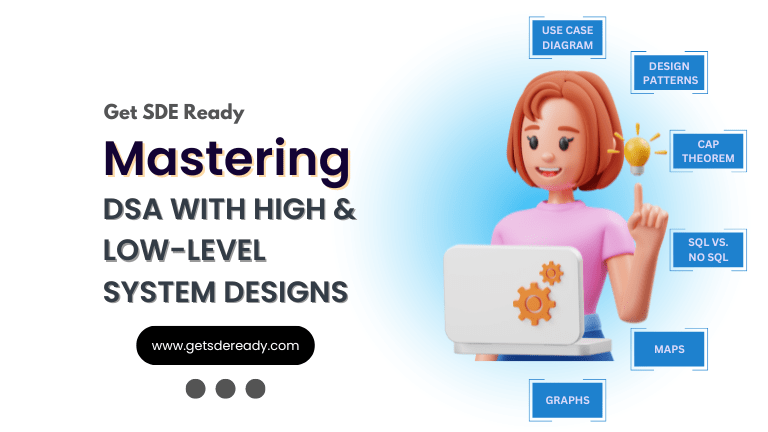
DSA, High & Low Level System Designs
- 85+ Live Classes & Recordings
- 24*7 Live Doubt Support
- 400+ DSA Practice Questions
- Comprehensive Notes
- HackerRank Tests & Quizzes
- Topic-wise Quizzes
- Case Studies
- Access to Global Peer Community
Buy for 52% OFF
₹25,000.00 ₹11,999.00
Accelerate your Path to a Product based Career
Boost your career or get hired at top product-based companies by joining our expertly crafted courses. Gain practical skills and real-world knowledge to help you succeed.
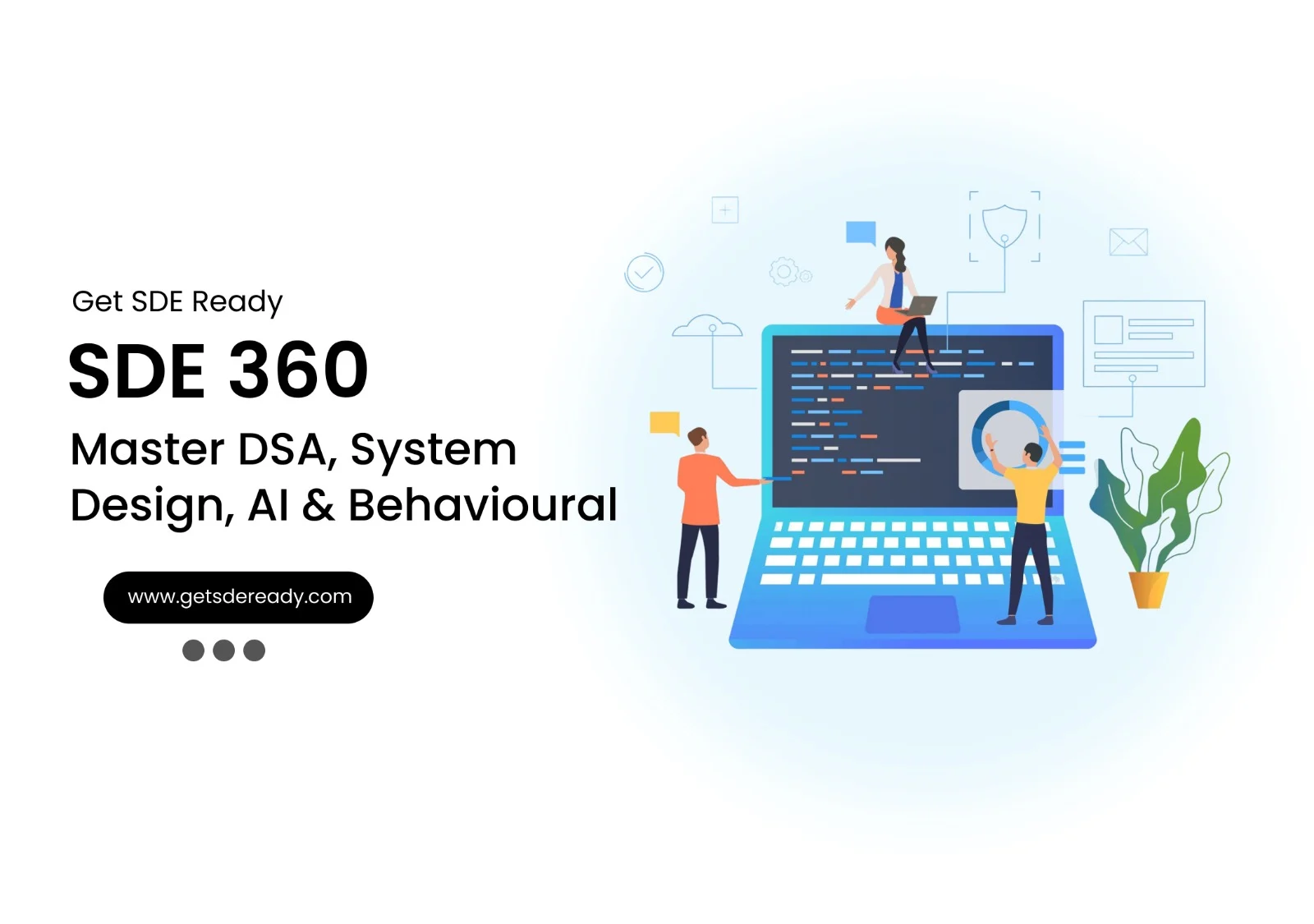
SDE 360: Master DSA, System Design, AI & Behavioural
- 100+ Live Classes & Recordings
- 24*7 Live Doubt Support
- 400+ DSA Practice Questions
- Comprehensive Notes
- HackerRank Tests & Quizzes
- Topic-wise Quizzes
- Case Studies
- Access to Global Peer Community
Buy for 50% OFF
₹39,999.00 ₹19,999.00

DSA, High & Low Level System Designs
- 85+ Live Classes & Recordings
- 24*7 Live Doubt Support
- 400+ DSA Practice Questions
- Comprehensive Notes
- HackerRank Tests & Quizzes
- Topic-wise Quizzes
- Case Studies
- Access to Global Peer Community
Buy for 52% OFF
₹25,000.00 ₹11,999.00
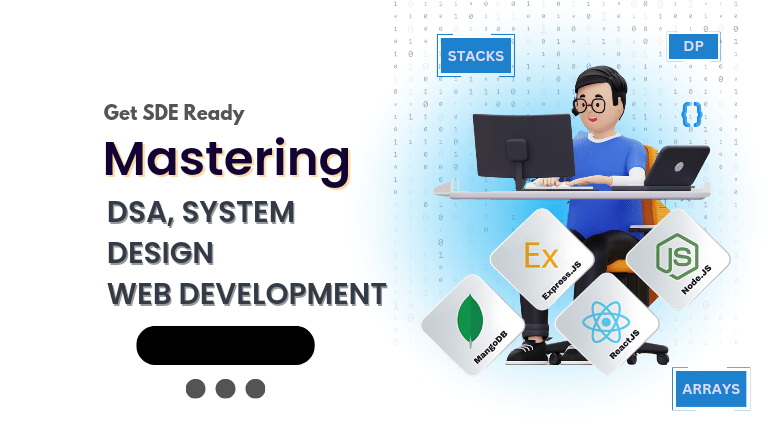
Fast-Track to Full Spectrum Software Engineering
- 120+ Live Classes & Recordings
- 24*7 Live Doubt Support
- 400+ DSA Practice Questions
- Comprehensive Notes
- HackerRank Tests & Quizzes
- 12+ live Projects & Deployments
- Case Studies
- Access to Global Peer Community
Buy for 51% OFF
₹35,000.00 ₹16,999.00
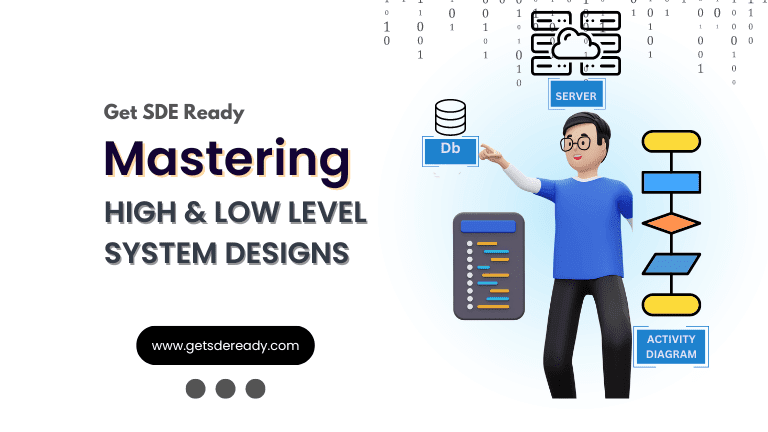
Low & High Level System Design
- 20+ Live Classes & Recordings
- 24*7 Live Doubt Support
- Case Studies
- Comprehensive Notes
- HackerRank Tests
- Topic-wise Quizzes
- Access to Global Peer Community
- Interview Prep Material
Buy for 60% OFF
₹20,000.00 ₹7,999.00
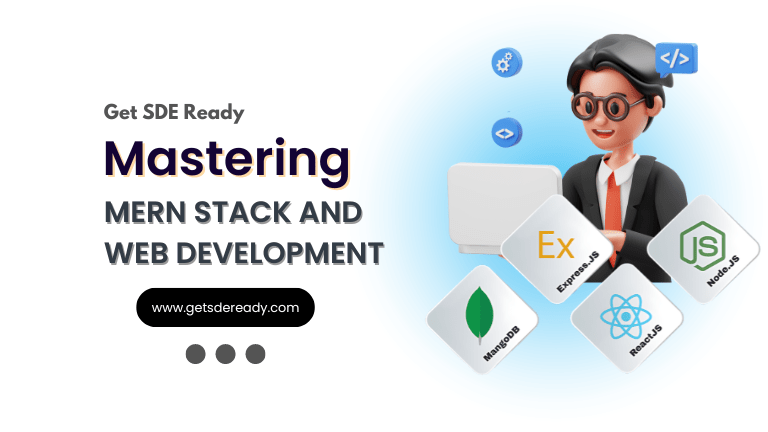
Mastering Mern Stack (WEB DEVELOPMENT)
- 65+ Live Classes & Recordings
- 24*7 Live Doubt Support
- 12+ Hands-on Live Projects & Deployments
- Comprehensive Notes & Quizzes
- Real-world Tools & Technologies
- Access to Global Peer Community
- Interview Prep Material
- Placement Assistance
Buy for 53% OFF
₹15,000.00 ₹6,999.00
Reach Out Now
If you have any queries, please fill out this form. We will surely reach out to you.
Contact Email
Reach us at the following email address.
arun@getsdeready.com
Phone Number
You can reach us by phone as well.
+91-97737 28034
Our Location
Rohini, Sector-3, Delhi-110085
